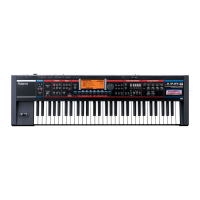10
Playing Rhythm Patterns
Press the RHYTHM PATTERN button so it lights and to 1
display the screen where you can start and stop rhythm
patterns.
As you may have noticed, F1-F6 have lit up. This is because you use these
buttons to select, start, and stop beats.
Press F1 (PAD 1)—the POP 1-1 beat starts playing. You can see its
2
name highlighted onscreen, as shown by the blue arrow above.
To stop the beat, press F1 (PAD 1) again.
3
Now press another pad to hear its rhythm pattern.4
As a beat plays, press another pad to hear how the JUNO-G seamlessly 5
switches between rhythm patterns.
Try playing along with the beat on the keyboard.
6
Whatever sound you had selected before you pressed the RHYTHM
PATTERN button is still there on the keyboard, and you can use it for
playing along with rhythm patterns.
Stop the beat that’s playing by pressing its F button.7
Changing the Beat Tempo
It’s easy to change the speed, or “tempo,” of a beat as it plays:
Press the TEMPO button—this opens the TEMPO window.
1
Change the tempo by tapping out a new tempo on the F4 (TAP) 2
button, or by turning the Value knob.
When you’re done changing the tempo, press F6 (CLOSE).
3
Rhythm Groups
Rhythm patterns are used in “rhythm groups.” A rhythm group contains
settings for the rhythm patterns to be played by the pads, how they’re
supposed to be played, and also selects an optimal rhythm set for them.
If the Rhythm Group parameter isn’t already selected—as it is in the
1
screenshot on the previous page—select it now.
Turn the Value dial or use the DEC/INC buttons to select a rhythm
2
group whose name sounds interesting to you.
Try out the selected rhythm group’s beats using F1-F6.
3
Changing a Beat’s Rhythm Set
If you’d like to use a different rhythm set for a rhythm group, select the Rhy
Part parameter as shown here:
Turn the Value dial or use DEC/INC to select the rhythm set you want.
The JUNO-G Arpeggiator
The JUNO-G’s polyphonic arpeggiator takes notes you play and makes
repeating patterns called “arpeggios” out of them. Arpeggios can provide
grooves, add texturing, and can also automatically generate bass lines for
chords. Each arpeggio pattern in the JUNO-G is called an arpeggio “style.”
They’re handy onstage and as elements within songs.
Rhythm patterns, the sequencer, and the arpeggiator all use the same
tempo, so they automatically stay perfectly in time with each other.

